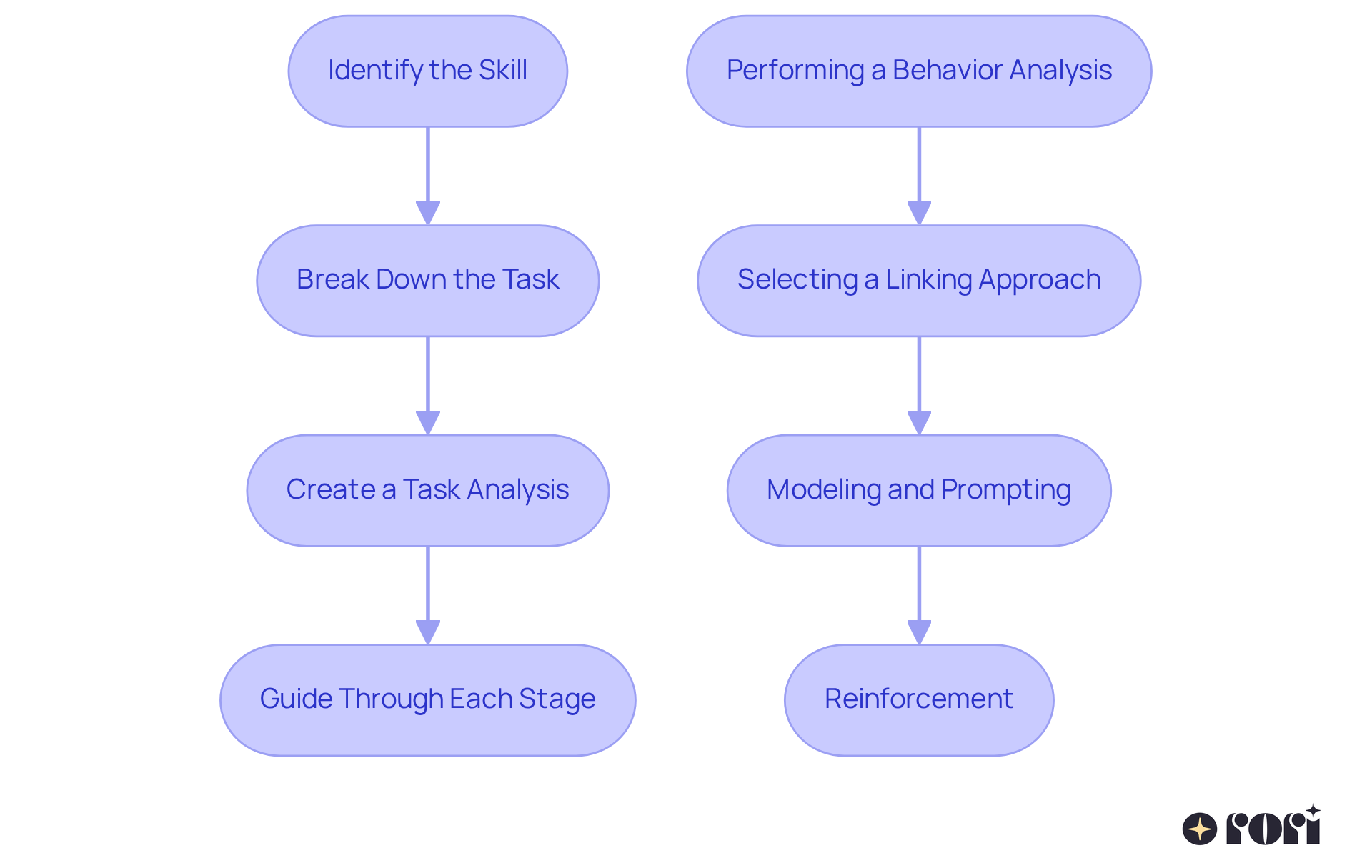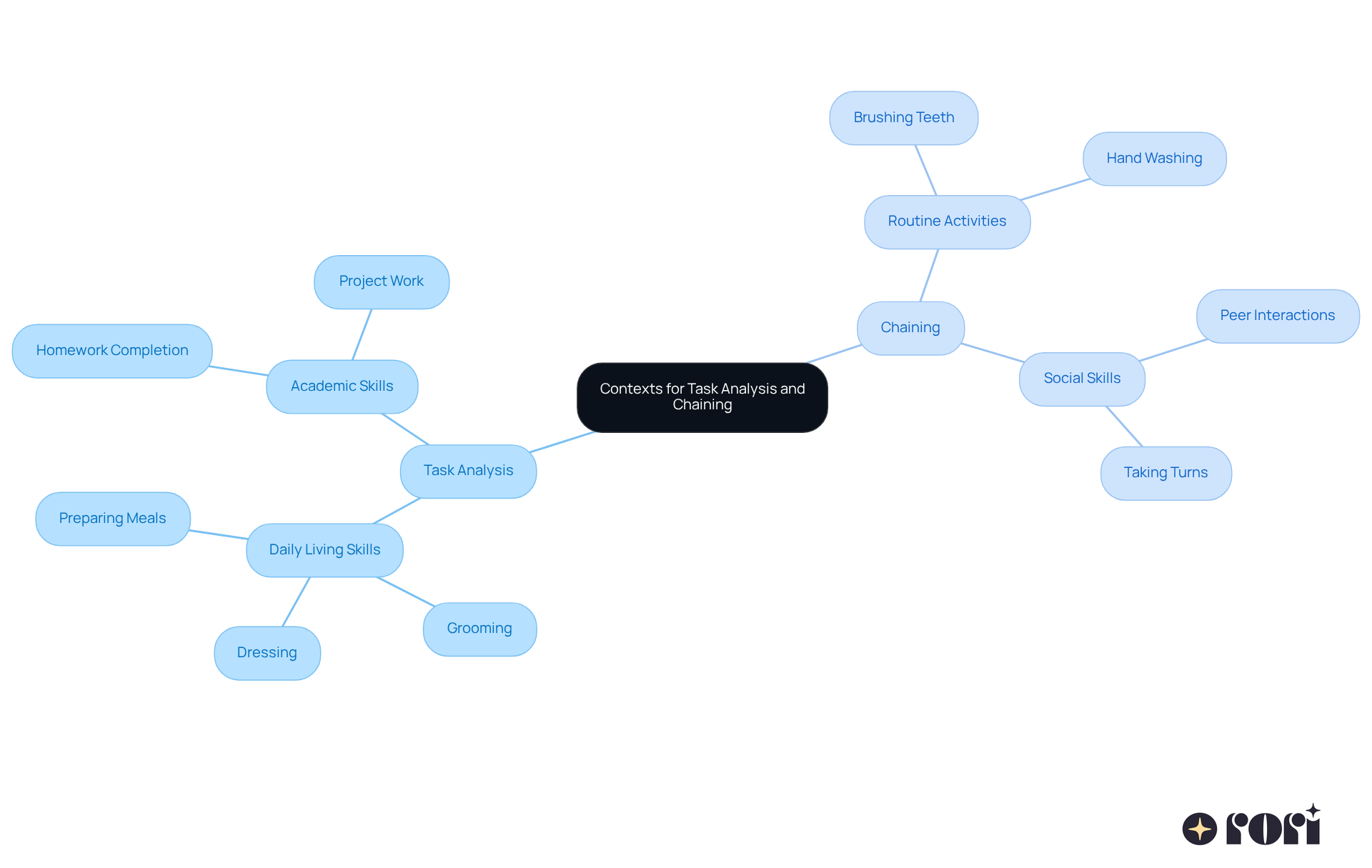Let’s explore the key differences between chaining and task analysis in ABA therapy! These two methods play a vital role in helping children, especially those with autism, acquire new skills.
Task analysis is all about breaking down tasks into manageable steps. This approach not only provides clarity but also allows for individualization, making it easier for each child to understand what they need to do. On the other hand, chaining takes those steps and integrates them into a sequence. This method promotes independence and motivation, enhancing the learning experience for our young learners.
By understanding these methods, we can better support our children on their learning journeys. Remember, we’re here to help you every step of the way!
Understanding the nuances of ABA therapy can be pivotal for parents navigating the complexities of behavioral interventions for their children. It’s a challenging journey, isn’t it? Among the most effective methodologies are task analysis and chaining. Both of these strategies simplify learning by breaking down tasks into manageable components, making it easier for kids to grasp new skills.
In this article, we’ll delve into how these strategies differ and the unique advantages they offer. Our goal is to guide you, the caregiver, in making informed choices about your child’s therapeutic journey. So, how can you determine which approach will best foster your child's independence and skill acquisition in everyday activities? Let’s explore this together!
Activity analysis is a structured approach in ABA therapy that utilizes chaining vs task analysis to break down complex processes into smaller, manageable parts. This method helps therapists pinpoint the specific actions needed to complete a task, making learning simpler for young learners. For instance, when teaching a child to wash their hands, it involves several steps:
This organized way of teaching allows caregivers to monitor progress clearly, observing each stage and identifying areas that might need a little tweak.
On the other hand, chaining vs task analysis refers to a technique that brings these individual actions together into a smooth sequence. There are a few ways to do this:
In the discussion of chaining vs task analysis, chaining is especially useful for tasks that require multiple actions to reach a final goal, like brushing teeth or making a sandwich. By using these techniques, therapists can enrich young learners' experiences and promote greater independence in their daily routines. Our dedicated behavior analysts regularly evaluate these methods, adjusting their strategies to ensure effective progress monitoring and support for both children and their caregivers. Did you know that according to the American Psychological Association, about 47% of kids receiving ABA therapy blend in seamlessly with their peers? This highlights just how impactful these techniques can be in nurturing positive behavioral outcomes. Let’s explore this together!

To effectively implement task analysis in ABA therapy, therapists typically follow these steps:
Now, let’s discuss chaining vs task analysis. The process involves:
These methodologies, when considering chaining vs task analysis, not only optimize instruction but also empower individuals with autism to master complex skills, enhancing their independence and quality of life. Research shows that structured task analysis can improve skill acquisition rates by 60-75% compared to traditional methods, and skills taught through task analysis are 45% more likely to generalize to new situations when implemented properly. Continuous evaluation and data gathering are essential for tracking progress and adjusting instructional strategies, ensuring that methods remain effective and tailored to each individual's unique requirements. This patient-focused approach, coupled with active caregiver participation and the flexibility of therapy, is vital for achieving significant improvement in youths with autism. Plus, it’s important to remember that ABA therapy is the only scientifically proven treatment for autism that is covered by insurance, making it accessible for families seeking support.
Let’s explore this together! We’re here to help you every step of the way!

![]()
Task analysis is a fantastic tool, especially when a child is learning new skills that involve several steps. For example:
On the other hand, chaining shines in situations where a child is learning a series of actions that lead to a specific outcome. Here are some examples:
By recognizing the differences in chaining vs task analysis, parents can better support their child's learning journey in ABA therapy. Caregiver education is key in complementing professional interventions, leading to a more personalized and effective approach to skill acquisition. Let’s explore this together!

Understanding the distinctions between chaining and task analysis in ABA therapy is essential for parents wanting to enhance their child's learning experience. Both strategies effectively break down and teach complex skills, but they do so from different perspectives. Chaining links individual actions into a cohesive sequence, while task analysis breaks tasks into smaller, manageable steps for clearer understanding.
Throughout this article, we’ve explored the benefits and limitations of both methods. Task analysis provides clarity and individualization, making it easier for children to grasp new skills. On the other hand, chaining promotes skill integration and motivation through a structured sequence of actions. Yet, each method has its challenges, like the potential for oversimplification with task analysis and the risk of dependency on prompts with chaining. Recognizing when to implement each technique can significantly impact your child's progress.
Ultimately, we encourage parents to engage actively in their child's ABA therapy journey. By understanding the nuances of chaining and task analysis, you can better support your child’s skill acquisition, fostering independence and confidence. Embracing these strategies not only enhances learning outcomes but also contributes to a more fulfilling daily life for children with autism. Let’s explore this together!
What is task analysis in ABA therapy?
Task analysis is a structured approach in ABA therapy that breaks down complex processes into smaller, manageable parts, helping therapists identify specific actions needed to complete a task.
Can you provide an example of task analysis?
An example of task analysis is teaching a child to wash their hands, which involves several steps: turning on the faucet, applying soap, scrubbing hands, rinsing, and drying.
How does task analysis benefit young learners?
Task analysis simplifies learning by allowing caregivers to monitor progress clearly, observing each stage and identifying areas that may need adjustment.
What is chaining in the context of ABA therapy?
Chaining is a technique that brings together individual actions into a smooth sequence, making it easier to teach tasks that require multiple actions to achieve a final goal.
What are the different types of chaining techniques?
The different types of chaining techniques include forward chaining (starting with the first step), backward chaining (beginning with the last step), and total process chaining (teaching all steps at once).
When is chaining particularly useful?
Chaining is especially useful for tasks that involve multiple actions, such as brushing teeth or making a sandwich.
How do behavior analysts use task analysis and chaining?
Behavior analysts regularly evaluate and adjust their strategies using task analysis and chaining to ensure effective progress monitoring and support for children and their caregivers.
What does research say about the effectiveness of ABA therapy techniques?
According to the American Psychological Association, about 47% of kids receiving ABA therapy blend in seamlessly with their peers, indicating the positive impact of these techniques on behavioral outcomes.